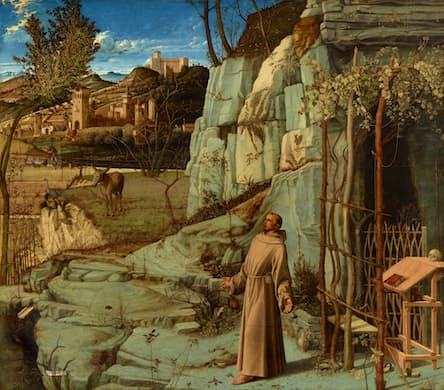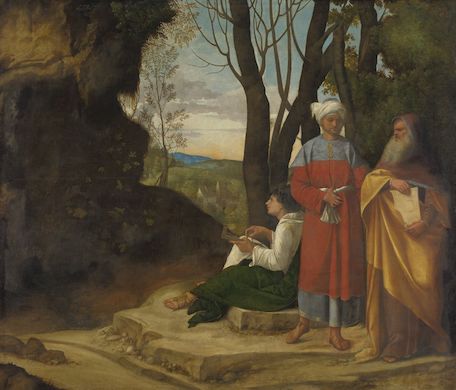On View at the Frick, a Little Slice of Heaven
Get up close to ‘St. Francis in the Desert,’ relish its meticulous details, and consider the notion that every last thing on God’s green earth is worthy of attention.

The worst thing you could say about “Bellini and Giorgione in the House of Taddeo Contarini,” an exhibition that just opened at the Frick Madison, is that the glare is annoying. Vienna’s Kunsthistorisches Museum, which has loaned Giorgione’s “Three Philosophers” (circa 1505-09) to the Frick, has seen fit to place the canvas behind glass. When this was done, I don’t know; the practice has long been commonplace. With the increased vociferousness with which the eco-righteous nitwits at Just Stop Oil are having at it with our common cultural patrimony — well, you can’t be too careful. Still, that glare? Annoying.
It may be unwise, then, to mention that the surface of “St. Francis in the Desert” (ca. 1475-80) by Giovanni Bellini is as free of glare as the day it left the artist’s studio. For those who enjoy nosing up to this-or-that painting, albeit at the risk of incurring the wrath of diligent security guards, the Frick’s decision to leave Bellini’s oil-on-panel unfettered is a boon. The role of touch in aesthetic delectation should never be discounted. That, and the natural light filtering upon “St. Francis” through the museum’s torsioned window, is like a benediction from on high. Heaven on East 75th Street — it’s real.
This inspired installation will be missed, if not permanently mourned, when the jewel of the Frick’s collection returns to its perch on Fifth Avenue and 70th Street late next year. In the meantime — or, at least, until February 4 — Bellini and Giorgione will be sharing the same space after having been separated for more than four centuries. Both pictures were once in the collection of Taddeo Contarini (circa 1466-1540), an aristocrat who lived at the Santa Fosca parish of Venice. The scion of a wealthy family, Taddeo dealt in wheat, wood, and meat, and was counted by one historian as among “the most famous intellectuals of his time.”
He certainly had good taste. We know about Taddeo’s collection from Marcantonio Michiel, a 16th-century scholar who decided to inventory the artworks he had seen in private hands throughout Venice and the Veneto. Along with “Three Philosophers” and “St. Francis in the Desert” — rightfully described by Michiel as being “wonderfully finished and refined” — the diligent studioso noted an additional two canvases each by Bellini and “Giorgio from Castelfranco,” as well as paintings by Jacopo Palma, Girolama Romanino, and a Milanese artist whose name has been lost to history. Most of the works have been lost as well, but the two that aren’t — well, they’re great.

“In the House of Taddeo Contarini” should prompt New Yorkers who have become blasé about the city’s cultural largesse to revisit “St. Francis in the Desert.” It is, as a colleague at the press preview noted, a picture that keeps on giving. Giovanni Bellini was but one of a family of painters and, though older brother Gentile was a star during their lifetimes, the younger brother’s reputation has eclipsed him on the strength of his crystalline colors and technical finesse. Get up close to the Frick picture, relish its meticulous details, and consider the notion that every last thing on God’s green earth is worthy of attention.
“The Three Philosophers” isn’t up to that standard, but calibrating gradations of mastery at a caliber this high can be a fool’s errand. Besides, there aren’t that many firm attributions for Giorgione. The cautious place it at three; the generous, around 10. Giorgione was something of a mystery and his imagery, too, doesn’t lend itself to ready explication. Is the Kunsthistorisches picture an homage to antiquity, with the rocky enclosure at left a stand-in for Plato’s cave? Or might it be the Three Kings, the builders of the Temple of Jerusalem, or, my favorite theory and the least likely, portraits of Bellini, Carpaccio, and Giorgione himself?
Those content to let the mystery be can visit the Frick Madison and take in a tête-à-tête that’s been stalled for a good chunk of time. As you might guess, Bellini and Giorgione have a lot to say to each other.

